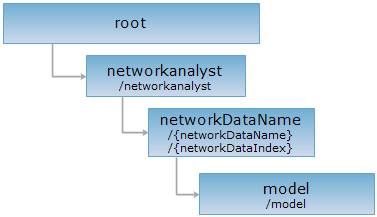URI
<networkDataName_uri>/model[.<format>]
Supported methods
Parent resource
Introduction
Reloads models used in the network analysis service.
Supported Methods:
- GET: Gets the current resources.
- PUT: Reloads models used in the network analysis service.
- HEAD: Checks whether the model resource exists or whether it has permission to access the resource.
Supported output formats: rjson, json, jsonp, html, xml.
Resource hierarchy

HTTP request methods
Implement the HTTP request on the following URI, where supermapiserver is the server name.
http://supermapiserver:8090/iserver/services/transportationanalyst-sample/rest/networkanalyst/RoadNet@Changchun/model
GET request
Gets the current resources.
PUT request
Reloads models used in the network analysis service.
No request parameter needed.
Response structure
| Field | Type | Description |
| succeed | boolean | Whether the weight of the edge was successfully updated. |
| errorMsg | String | Details about the error if failure occurs. |
| code | int | Code of the error. |
Response example
Reloads the model for RoadNet@Changchun, perform PUT request to http://supermapiserver:8090/iserver/services/transportationanalyst-sample/rest/networkanalyst/RoadNet@Changchun/model.rjson, the response result returned is:
{
"succeed":true
}
HEAD request
Asks for the response identical to the one that would correspond to a GET request, but without the response body. This is useful for retrieving meta-information written in response headers, without having to transport the entire content. The meta-information includes the media-type, content-encoding, transfer-encoding, content-length, etc.
The HEAD request helps check the existence of the model resource and whether it can be accessed by the client. By implementing the HEAD request on the URI, with .<format> appended to the end, we can quickly get to know whether the model resource supports the representation in <format> or not.